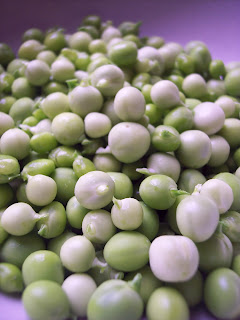Peas
Some of my earliest memories of gardening revolve around raiding the pea patch. I can still remember the excitement of cracking open a pod and eating the sweet peas within. The sound of the birds and wind traveling through the pines that surrounded the garden still fills my mind with pleasant memories. I can recall lugging the watering can from my grandfathers hose to the pea plot while the cool aluminum struck my thigh every other step as cold water soaked my sneakers. Those days in the pea patch nearly four decades ago left such an imprint that one of the first things I grew in my own garden was a pea patch.
For a number of years I have grown yellow snap peas. This year though I took a different route and dug out a section of the garden for shell peas. Something I have not had in the garden for far too long. I purchased an English dwarf variety from Fedco seeds out of Maine. I have not been disappointed they are wonderful! In fact my oldest daughter told me she thought that they tasted like cantaloupe, they really are exceptionally sweet.
Peas are one of the earliest crops to go into the ground. Here in New York state I have a number of friends who aim for St. Patricks day to plant. This year due to heavy snow and below average temperatures nothing of the sort happened but the overall point is you can plant them as soon as you can work the ground.
One thing you want to keep in mind is that peas are vigorous climbers so you will want to provide some sort of trellis for them. We tend to use old branches lying in the woods and create small tepee shaped formations in the patch.
Peas are a healthy snack as well. They provide a significant boost of vitamin C not to mention iron and fiber. They are also beneficial in regards to healthy bones, containing nearly 44% of your daily vitamin K in a one cup serving. They are great for blood sugar regulation too.
They are not only good for you but for your soil too. They work with bacteria in your soil to provide nitrogen for your plants and also break down reasonably easy in your soil as a cover crop.
If you happen to grow heirlooms as I do they are one of the easiest plants to collect and store seed from. Simply allow some of the earliest pods to stay on the plant until they become brittle and brown and then remove the dried pea from its pod. If they are still a bit damp allow them to dry on a cookie sheet for a few days. I simply put them in a jar in the fridge until the following season.
Enjoy!
For a number of years I have grown yellow snap peas. This year though I took a different route and dug out a section of the garden for shell peas. Something I have not had in the garden for far too long. I purchased an English dwarf variety from Fedco seeds out of Maine. I have not been disappointed they are wonderful! In fact my oldest daughter told me she thought that they tasted like cantaloupe, they really are exceptionally sweet.
Peas are one of the earliest crops to go into the ground. Here in New York state I have a number of friends who aim for St. Patricks day to plant. This year due to heavy snow and below average temperatures nothing of the sort happened but the overall point is you can plant them as soon as you can work the ground.
One thing you want to keep in mind is that peas are vigorous climbers so you will want to provide some sort of trellis for them. We tend to use old branches lying in the woods and create small tepee shaped formations in the patch.
Peas are a healthy snack as well. They provide a significant boost of vitamin C not to mention iron and fiber. They are also beneficial in regards to healthy bones, containing nearly 44% of your daily vitamin K in a one cup serving. They are great for blood sugar regulation too.
They are not only good for you but for your soil too. They work with bacteria in your soil to provide nitrogen for your plants and also break down reasonably easy in your soil as a cover crop.
If you happen to grow heirlooms as I do they are one of the easiest plants to collect and store seed from. Simply allow some of the earliest pods to stay on the plant until they become brittle and brown and then remove the dried pea from its pod. If they are still a bit damp allow them to dry on a cookie sheet for a few days. I simply put them in a jar in the fridge until the following season.
Enjoy!
Tobias Whitaker blogs
for Mother Earth News and Grit Magazine. Click on the Mother Earth News logo at
the bottom of the page for all of his post. You can also find him on Facebook
at Seed To Harvest: Bossy Hen Homestead https://www.facebook.com/seedtoharvestbossyhenhomestead/
which is a central location for his homesteading blogs and his homeschooling
blog, A Mile In Her Shoes: Tales Of A Stay-At Home Dad found here https://amileinhershoestalesofastayathomedad.wordpress.com/



Comments
Post a Comment